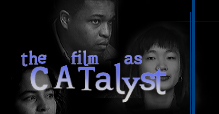The role of the facilitator is to create an atmosphere where everyone can express their thoughts and feelings, and listen to and learn from the different perspectives offered by each participant. Facilitators are also responsible for helping to clarify discussion goals and for maintaining safe, respectful group processes. What follows are facilitation recommendations that help create such an atmosphere.
Ask the group to make the following agreementsListen to each other with respect; Use “I” statements; Speak about your own thoughts, reactions, feelings, and experiences, not those of others; Do not debate someone else’s experience. If they say ____ happened, do not argue with their statement.
To insure that the person speaking is not interrupted, have those who wish to speak raise their hands. Or use the “talking stick” tradition. (Using any item available a marker, paper cup, or rolled up piece of paper establish the rule that those who wish to speak must have this item in their hand. After one person speaks, the item gets passed to the next person who wants to share).
Watch for domination in the discussion by persons who generally have a voice on these issues (men, whites, etc.).
At the beginning of the discussion, and at appropriate places throughout, break out into two person “dyads” so that everyone has an opportunity to say aloud what is on their mind. Often times people will feel more safety in a one-on-one interaction. Dyads should be short, with time divided between the two participants to talk and to listen. Instruct the group that one person will talk while the other listens; the listener does not interrupt or ask questions; the facilitator keeps time and lets the group know when to switch from speaker to listener.
Gradually move the group from talking about the film to their personal experiences with racism.
When/if the discussion lags ask questions about specific sections of the film. (See Using References From the Film)
Allow for moments of silence.
Do not simply go from one person to the next. When you hear something that is moving to you, something that you think may be a good point for the group to discuss, ask the person speaking to say more (go deeper with their comment).
Plan your agenda. If possible schedule 2-3 hours for the film showing and discussion. A sample agenda might be as follows:
- Opening remarks setting the stage
- Participant introductions (if group is small)
- Dyad”What do you want to have happen today?”
- Have a few people share their answers
- Give background information on the film
- Show film
- To allow participants a low-risk opportunity to share their immediate
emotional response, start the discussion with the dyads - Open discussion in large group
- End the discussion by going around the group and having participants
answer the question, “What is your next step for ending racism; What
did you learn today?” (Remind participants that they can pass if they
don’t wish to answer).
To help the participants not feel overwhelmed or too discouraged by the magnitude of racism it’s important to help them frame the issue in a personal context. Emphasize that any effort at change is meaningful and that what may be easy for one participant may be risky for another.
Whenever possible work with at least two faciltators. This allows one co-facilitator to focus upon emotional or group process while another is paying attention to content and activities or is keeping track of the discussion. Working in pairs also helps build a pool of facilitators by partnering novice facilitators with those more experienced.
Make every effort to have your pairs of facilitators be racially mixed. This will create more safety in mixed groups and help participants speak from their own racial perspective. It also (ideally!) models trust, cooperation, and alliance behaviors between the facilitators, as well as modeling differences of perspective based on different life experience.






